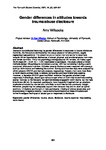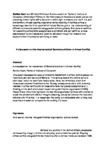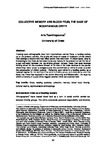An evaluation of the use of a two-tiered trauma team activation system in a UK major trauma centre: Table 1
| dc.contributor.author | Jenkins, P | |
| dc.contributor.author | Rogers, J | |
| dc.contributor.author | Kehoe, A | |
| dc.contributor.author | Smith, JE | |
| dc.date.accessioned | 2016-04-22T12:11:55Z | |
| dc.date.available | 2016-04-22T12:11:55Z | |
| dc.date.issued | 2015-05 | |
| dc.identifier.issn | 1472-0205 | |
| dc.identifier.issn | 1472-0213 | |
| dc.identifier.uri | http://hdl.handle.net/10026.1/4534 | |
| dc.description.abstract |
OBJECTIVES AND BACKGROUND: Appropriate activation of multidisciplinary trauma teams improves outcome for severely injured patients but can disrupt normal service in the rest of the hospital. Derriford Hospital uses a two-tiered trauma team activation system. The emergency department trauma team (EDTT) is activated in response to a significant traumatic mechanism; the hospital trauma team (HTT) is activated when this mechanism coexists with physiological abnormality or specific anatomical injury. The aim of this study was to compare characteristics, process measures and outcomes between patients treated by EDTTs or HTTs to evaluate the approach in a UK setting. METHODS: A retrospective database review was performed using Trauma Audit Research Network (TARN) and the local source trauma database. Patients who activated a trauma team between 1 April and 30 September 2012 were included. Patients were categorised according to the type of trauma team activated. Data included time to X-rays, time to CT, time to intubation, numbers discharged from ED, intensive care unit admission, injury severity score and mortality. RESULTS: During the study period, 456 patients activated a trauma team with 358 EDTT and 98 HTT activations. Patients seen by the ED team were significantly less likely to have severe injury or require hospital admission, intubation, emergency operation or blood transfusion. Differences in time taken to key investigations were statistically but not clinically significant. CONCLUSIONS: A two-tiered trauma team activation system is an efficient and cost-effective way of dealing with trauma patients presenting to a major trauma centre in the UK. | |
| dc.format.extent | 364-367 | |
| dc.format.medium | Print-Electronic | |
| dc.language | en | |
| dc.language.iso | eng | |
| dc.publisher | BMJ | |
| dc.subject | major trauma | |
| dc.subject | trauma team activation | |
| dc.subject | two-tier trauma team | |
| dc.subject | Adult | |
| dc.subject | Blood Transfusion | |
| dc.subject | Emergency Service, Hospital | |
| dc.subject | Hospital Rapid Response Team | |
| dc.subject | Humans | |
| dc.subject | Injury Severity Score | |
| dc.subject | Intubation, Intratracheal | |
| dc.subject | Middle Aged | |
| dc.subject | Patient Admission | |
| dc.subject | Retrospective Studies | |
| dc.subject | Trauma Centers | |
| dc.subject | United Kingdom | |
| dc.subject | Whole Body Imaging | |
| dc.subject | Wounds and Injuries | |
| dc.subject | Young Adult | |
| dc.title | An evaluation of the use of a two-tiered trauma team activation system in a UK major trauma centre: Table 1 | |
| dc.type | journal-article | |
| dc.type | Article | |
| plymouth.author-url | https://www.ncbi.nlm.nih.gov/pubmed/24668398 | |
| plymouth.issue | 5 | |
| plymouth.volume | 32 | |
| plymouth.publication-status | Published | |
| plymouth.journal | Emergency Medicine Journal | |
| dc.identifier.doi | 10.1136/emermed-2013-203402 | |
| plymouth.organisational-group | /Plymouth | |
| plymouth.organisational-group | /Plymouth/Faculty of Health | |
| plymouth.organisational-group | /Plymouth/Users by role | |
| dc.publisher.place | England | |
| dcterms.dateAccepted | 2014-03-01 | |
| dc.identifier.eissn | 1472-0213 | |
| dc.rights.embargoperiod | Not known | |
| rioxxterms.versionofrecord | 10.1136/emermed-2013-203402 | |
| rioxxterms.licenseref.uri | http://www.rioxx.net/licenses/all-rights-reserved | |
| rioxxterms.licenseref.startdate | 2015-05 | |
| rioxxterms.type | Journal Article/Review |




